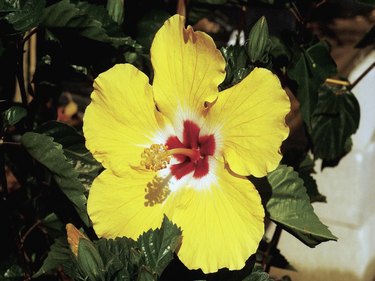
Hibiscus (Hibiscus spp.) are known for their dinner-plate-sized blooms in bright colors. Hibiscus bloom in late summer when many other perennials are past their prime. You can keep the blooms going into fall by deadheading the blooms, as this will encourage more blooms.
How to Deadhead Hibiscus
Video of the Day
Once a hibiscus bloom is spent, it will droop and look a bit bedraggled. Deadheading will not only encourage more blooms but it will help your hibiscus look neat and tidy. Deadhead hibiscus blooms by pinching the flower at the base of the bloom just above the stem.
Video of the Day
You don't have to deadhead hibiscus to keep the plant healthy, so don't stress about not deadheading the plant. However, if you do deadhead them, you will get more blooms, and since hibiscus have such unusual-looking flowers, extra blooms may be worth the effort. Deadheading hibiscus encourages both hardy and tropical hibiscus to continue flowering. Removing spent blooms encourages hibiscus to put its energy into creating additional flowers.
Both tropical and hardy hibiscus offer stunning, paper-thin blooms that have an exotic look. Tropical hibiscus (Hibiscus rosa-sinensis) and hardy or perennial hibiscus (most commonly Hibiscus moscheutos or Hibiscus coccineaus) bear blooms from 4 to 9 inches in diameter in colors including pink, red, yellow, orange, multicolor and occasionally white or purple.
Pruning Tropical or Hardy Hibiscus
To keep those bold flowers coming all summer, hibiscus also benefits from pruning. If you have a tropical hibiscus, hardy in U.S. Department of Agriculture hardiness zones 10 and 11, experts recommend that while the plant is growing in summer, you should prune up to one-third to control the plant's size and shape.
For perennial hibiscus varieties, hardy in USDA zones 4 to 9, you should wait until you see new shoots sprout up from the soil in spring before you cut back the stalks from the growth the previous year. To encourage a second round of blooming in summer, cut the new growth back by one-third. When the plant goes dormant for winter, resist the urge to cut the hibiscus back to the ground.
Proper pruning will help your hibiscus produce more flowers during the growing season. Prune the top 1/4 to 1 inch of green growth to encourage a fuller bush. After your plant has bloomed, selectively prune no more than one-third of your branches for a second growth.
Caring for Hibiscus
Planting a hibiscus properly will result in a shrub that produces spectacular blooms year after year. Perennial hibiscus varieties do best in well-drained, acidic soil that has been amended with organic matter. Plant the hibiscus so the crown of the plant is level with the soil or just above it. Make sure you plant multiple hibiscus several feet apart to give them room to grow.
Perennial hibiscus does best in full sun unless you live in an area with very hot summers, where they may benefit from some afternoon shade. Do not let the soil completely dry. Tropical hibiscus needs moist and well-drained but not saturated soil. If you live in an area where the temperature goes below 50 degrees at night, however, consider planting tropical hibiscus in a large pot.
With the right indoor care, tropical hibiscus can be a summer plant even in very cold locations. Whether you have tropical hibiscus or one of the perennial hibiscus varieties, provide a balanced organic fertilizer in spring without too much phosphorus.
- Hidden Valley Hibiscus: Hibiscus Plant Care: Pruning Hibiscus
- Miracle-Gro: How to Grow Hibiscus
- University of Minnesota Extension: Hibiscus
- Proven Winners: Types of Hibiscus – Hibiscus Wears Many Hats
- Kentucky Living: Should You Pull Dead Flowers Off Hibiscus Plant?
- American Meadows: How to Care and Grow Hardy Hibiscus